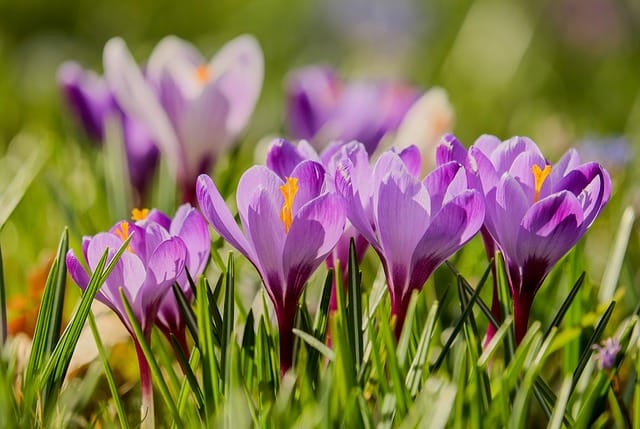How to grow Crocuses
Crocuses are vibrant and colorful perennial flowers that are known for their early spring bloom

In this article:
- Introduction to Crocuses
- Types and Varieties of Crocuses
- Choosing the Right Location
- Soil Preparation for Crocuses
- Planting Crocus Bulbs
- Watering and Nutrient Requirements
- Sunlight and Temperature Needs
- Mulching and Weed Control
- Pruning and Deadheading Crocuses
- Dealing with Pests and Diseases
- Tips for Extending Crocus Blooms
- Propagating Crocuses
- Storing and Replanting Crocus Bulbs
- Landscaping and Design Ideas with Crocuses
- Enjoying Crocuses Indoors
- Frequently Asked Questions about Growing Crocuses
- Conclusion
Introduction to Crocuses
Crocuses are vibrant and colorful perennial flowers that are known for their early spring bloom. They are easy to grow and can be a delightful addition to any garden or landscape. In this article, we will provide you with comprehensive information on how to grow crocuses successfully.
Types and Varieties of Crocuses
There are several types and varieties of crocuses available, each with its own distinctive characteristics. Some popular varieties include the Large Dutch Crocus, Snow Crocus, and Spring Crocus. Research and choose the varieties that best suit your climate and aesthetic preferences.
Choosing the Right Location
Crocuses prefer well-draining soil and require full sun to flourish. Find a location in your garden or landscape that receives at least 6 hours of direct sunlight each day. Additionally, ensure that the area is protected from strong winds.
Soil Preparation for Crocuses
Prepare the soil before planting your crocus bulbs. The soil should be loose, fertile, and have a pH level between 6 and 7. Incorporating organic matter such as compost or well-rotted manure can improve soil fertility and drainage.
Planting Crocus Bulbs
The best time to plant crocuses is during the fall, around 6-8 weeks before the first frost. Plant the bulbs at a depth of 2-3 inches, with the pointed end facing upward. Space the bulbs 3-4 inches apart to allow room for growth.
Watering and Nutrient Requirements
Crocuses require regular watering, especially during dry spells. Keep the soil moist but not waterlogged. Apply a balanced fertilizer during the growing season to provide essential nutrients for healthy growth.
Sunlight and Temperature Needs
As mentioned earlier, crocuses need full sun to thrive. They also require a period of cold dormancy during the winter. Most crocus varieties can tolerate cold temperatures down to -10°F (-23°C).
Mulching and Weed Control
Mulching can help retain moisture and control weed growth around your crocuses. Apply a layer of organic mulch, such as wood chips or straw, around the plants. Ensure that the mulch is not touching the flowers or foliage directly.
Pruning and Deadheading Crocuses
After the crocus flowers have finished blooming, remove the faded flowers (or deadhead) to prevent the plant from expending energy on seed production. Allow the foliage to die down naturally, as it helps to replenish nutrients in the bulb for next year's growth.
Dealing with Pests and Diseases
Crocuses are relatively resistant to pests and diseases. However, they can occasionally be affected by squirrels, rodents, or fungal diseases. Protect your bulbs by using wire mesh or planting them in containers. If necessary, consult a horticulturist for pest or disease control methods.
Tips for Extending Crocus Blooms
If you want to extend the blooming period of your crocuses, consider planting different varieties that bloom at different times. This will result in a longer and more continuous display of colorful flowers throughout the spring season.
Propagating Crocuses
Crocuses can be propagated through seed or by dividing the bulbs. Seed propagation is more time-consuming and may not result in flowers for several years. Dividing the bulbs every three to four years can help rejuvenate the plants and promote better flowering.
Storing and Replanting Crocus Bulbs
If you need to lift and store your crocus bulbs, do so after the foliage has died back completely. Store them in a cool, dry place until the fall planting season. Remember to label each variety for easy identification when replanting.
Landscaping and Design Ideas with Crocuses
Crocuses can be planted in groupings or scattered throughout the garden to create vibrant displays. They look great when combined with other early spring flowering bulbs such as daffodils and tulips. Experiment with different color combinations and planting patterns to enhance your garden's visual appeal.
Enjoying Crocuses Indoors
Crocuses can also be grown indoors in containers. Plant the bulbs in well-draining potting soil and place them in a sunny window. Enjoy the beauty and fragrance of these lovely flowers even during the colder months.
Frequently Asked Questions about Growing Crocuses
- Can crocuses grow in shade?
- How deep should I plant crocus bulbs?
- When should I fertilize my crocuses?
- What are the common pests and diseases that affect crocuses?
Conclusion
Growing crocuses can be a rewarding and enjoyable gardening experience. By following the guidelines and tips provided in this article, you can successfully cultivate these beautiful flowers and brighten up your garden with their vibrant colors. Happy crocus gardening!
